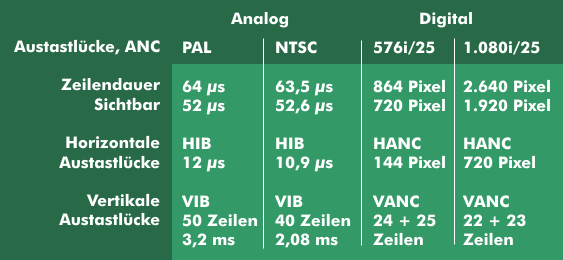blanking interval (BI)
Blanking gaps are signal parts of the classic analog television and video signals. There are two different blanking intervals: the vertical blanking interval, which is the picture blanking interval, and the horizontal blanking interval, which is the line blanking interval. The blanking interval is where the line and image change, which is darkened by the blanking signal.
The horizontal blanking signal darkens the TV or video picture when the beam is returned from the end of a line to the beginning of a line, i.e. during the line return. When the beam is set from the lower end of the picture to the upper beginning of the picture after the end of a field, i.e. during the picture change, it is blanked by the vertical blanking signal. According to the task and the pulse width one speaks of the horizontal and vertical blanking pulses and in the case of the display of blanking gaps.
During the blanking interval, the synchronization pulses for horizontal and vertical synchronization are also transmitted, and in the vertical blanking interval, further equalization pulses are transmitted, which provide level equalization at the end of a field. In addition, teletext, the electronic program guide ( EPG) and TV test signals are transmitted in the vertical blanking.
The horizontal blanking interval (HBI) has a duration of 12 µs according to CCIR. This means that of the line duration, which is 64 µs, 12 µs are blanked, i.e. only 52 µs are effectively used to display a line.
According to RS-170A, which specifies the NTSC standard, the blanking interval is 10.9 µs, and the effective line duration is 52.66 µs, since the total line duration is 63.556 µs.
The vertical blanking interval (VBI) consists of a total of 50 lines for CCIR and 40 lines for RS-170A. Some of these are used for the transmission of test signals and for teletext. However, the vertical blanking interval starts 2.5 lines before the frame change pulses and ends 2.5 lines after the frame synchronization pulse.
In digital TV, the blanking interval is replaced by the ancillary data space( ANC). This is extremely different and depends on the corresponding digital TV standards. There, the adequate vertical and horizontal gaps are called Vertical Ancillary Data Space (VANC) and Horizontal Ancillary Data Space (HANC).



